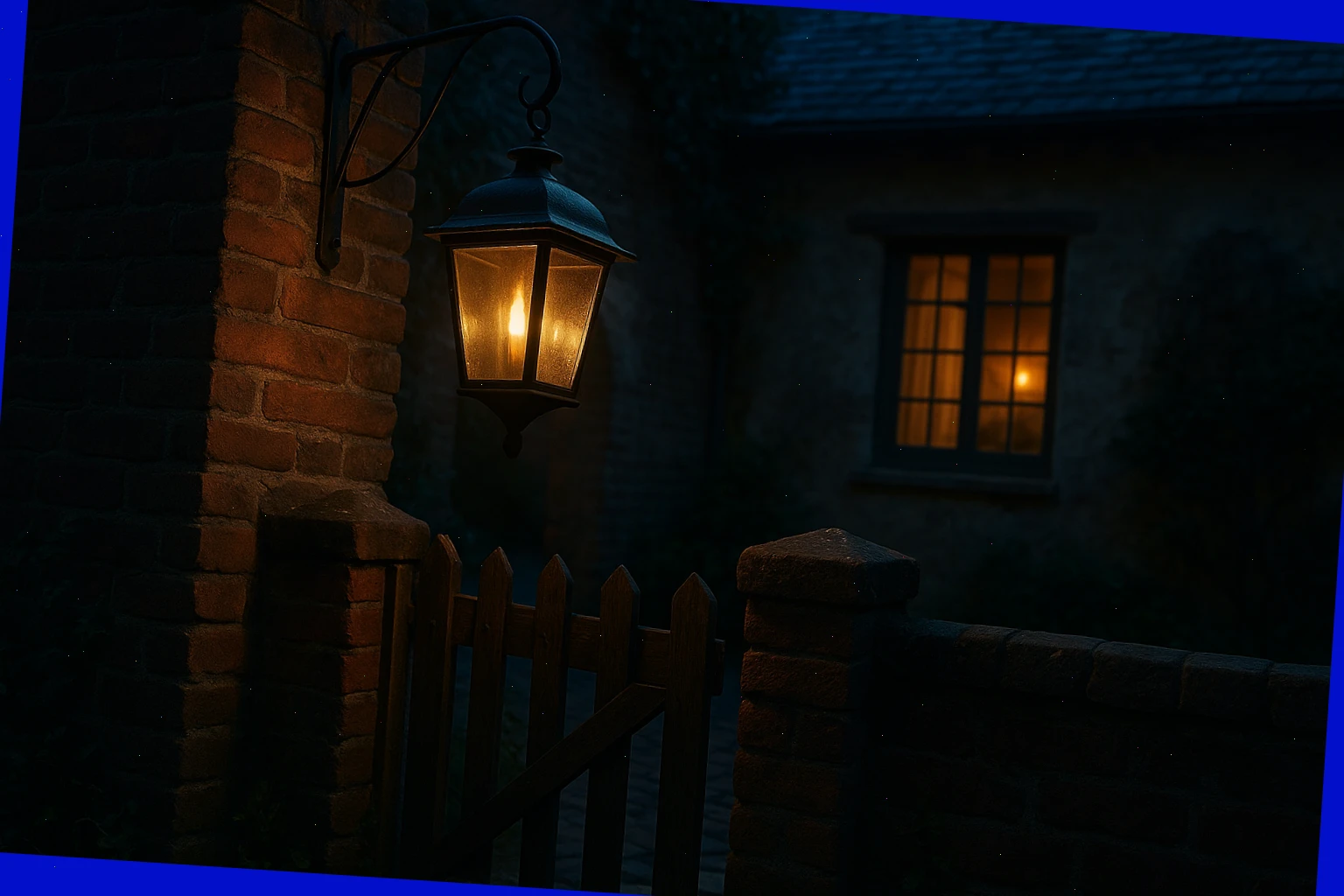Gate Lantern, Two Lines Later

The walk began, as so many of ours do, not with a grand announcement but with something quietly glowing. A lantern, hung at shoulder height, swayed near the edge of a small iron gate. It was not lit for guidance, nor for ceremony. It was simply there, a modest object in a modest place, and yet it caught every eye that passed. For us, this was enough to begin a nonsense route. The phrase formed quickly: “Gate lantern, two lines later.” A fragment, a prompt, an invitation.
First Impressions
Why do lanterns draw attention even when they are not lit? Perhaps because they are always on the cusp of function. They remind us of light even in daytime, of stories told after dark, of journeys made with shadows pressing in. The gate itself was ordinary: black bars, a simple latch, nothing ornate. Yet with the lantern, it felt staged, as if the space behind was waiting for actors. The mind leapt ahead. Two lines later, a play began.
The Prompt in Action
On this route, we asked walkers to stop at the lantern, take out their notebook, and write two lines. Not one line, not three. Exactly two. The rule was arbitrary, but nonsense thrives on such constraints. One participant wrote: “A gate holds back the ordinary / the lantern invites the absurd.” Another scribbled: “Step in, step out / the hinge does not mind.” The beauty lay not in literary polish but in noticing, distilling, and framing a moment.
Later we saw how the two-line rule forced economy. Some chose rhyme, some prose, some fractured dialogue. Children tended toward sound play: “Ting-tong, ding-dong.” Adults drifted toward metaphor. Together, the fragments became a chorus, held loosely by the image of one glowing object.
Walking Onward
After the gate, the path curved toward a yard paved with uneven stones. We encouraged people to carry the rhythm of their two lines with them. Once you set a cadence on paper, your steps often echo it. A woman reported that her couplet, written in haste, later guided her pace: “Slow as rain, fast as gulls / the gate forgets, the lantern recalls.” She claimed her stride matched the syllables without conscious effort.
The Role of Objects
Objects along a walk gain weight when named. A gate is no longer a gate once you call it “a threshold.” A lantern ceases to be hardware once you call it “a patient witness.” Our nonsense tradition builds on this: objects are characters waiting for a single adjective to set them loose. Two lines are just enough to assign that role without belabouring it.
Odd Associations
Nonsense is not random. It grows from sideways links. One participant linked the lantern to a memory of being sent to fetch water after dusk. Another connected it to stage curtains at a local theatre. A third insisted it resembled the moon in a steel cage. None of these were “true” descriptions, yet each turned an overlooked object into a seed of narrative.
When It Rains
Rain changes everything. The lantern’s glass fogged, its handle slickened, the gate creaked louder. Writers found themselves adding watery sounds to their couplets. One child wrote: “Drip-drop, the lantern hums / slip-slop, the gate becomes.” In wet weather, two lines became percussion more than poetry, a nonsense rhythm for splashing feet.
Listening Back
At the end of the walk we gathered under a shelter and read aloud. The chorus was peculiar: no two couplets alike, yet all tethered by the image of one lantern. Some lines were serious, others ridiculous, some only half legible. But in the reading, nonsense took full shape. It was less about individual brilliance and more about shared play. A passer-by, overhearing us, asked if we were rehearsing for theatre. We smiled: in a sense, yes.
Reflections on Constraint
The two-line rule revealed how little is needed to spark invention. Too much freedom overwhelms; a small rule channels energy. This is a principle we return to often: nonsense grows best in a narrow bed. A gate, a lantern, and two lines — the rest unfolds naturally.
Practical Notes
For those who wish to repeat this prompt elsewhere, here are simple guidelines:
- Find an ordinary object in an ordinary place.
- Assign it a title: “Gate lantern,” “Stone step,” “Leaning post.”
- Require exactly two lines in response.
- Gather and read the results aloud without comment.
- Notice how the collective sound shifts the meaning of the object.
Closing the Gate
When we left the yard, the lantern still swayed, indifferent to our words. Yet we carried fragments away: notebooks filled with couplets, laughter shared at odd rhymes, and the knowledge that nonsense does not require elaborate settings. It requires only a willingness to stop, notice, and respond.
Gate lantern, two lines later. That phrase remains in our logbook, not as a conclusion but as a beginning for whoever reads it next. If you pass a lantern tomorrow, whether at a gate or a garage or a garden path, consider giving it two lines. You may find nonsense waiting just beyond the latch.
Published on: 29 September 2025